As a home cook who's spent years perfecting Filipino classics, I've discovered that mastering Filipino Pork Afritada is truly a culinary milestone. While it might seem similar to other tomato-based Filipino stews, this beloved dish stands apart with its distinctive combination of tender pork chunks, perfectly cooked vegetables, and a rich, clear tomato sauce that strikes an ideal balance between savory and subtle sweetness.
What started as a journey to understand the nuances between Menudo and Afritada has evolved into crafting this foolproof recipe that consistently delivers restaurant-quality results. After countless family lunches and potluck celebrations, I'm excited to share my tested version of this Filipino comfort food classic, one that honors traditional techniques while ensuring success even for novice cooks.
Jump to:
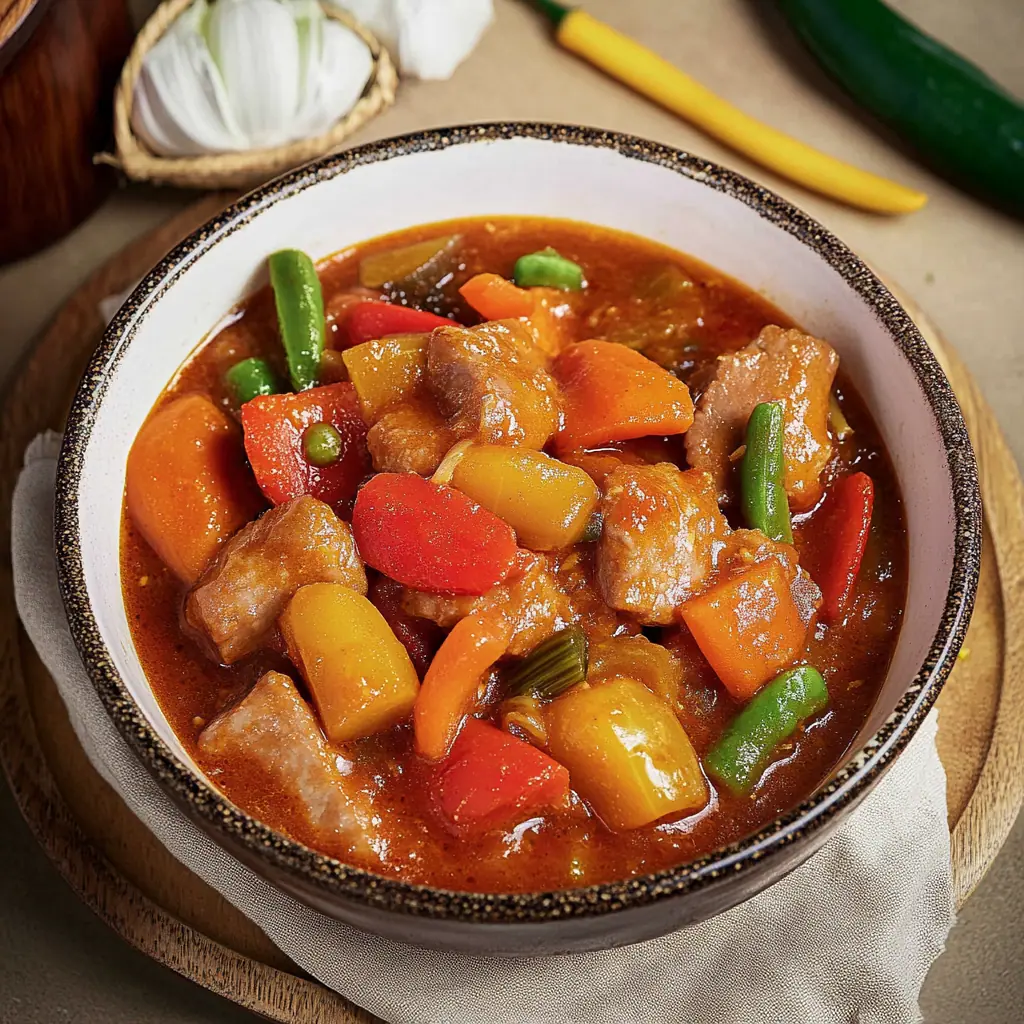
Why You'll Love This Recipe
- One-pot comfort food that's perfect for family dinners
- Restaurant-quality results with simple pantry ingredients
- Make-ahead friendly – tastes even better the next day
- Versatile recipe that works with different meats
- Kid-friendly way to incorporate vegetables
- Perfect balance of savory and slightly sweet flavors
- Great for batch cooking and meal prep
Ingredients
The combination of pork, tomatoes, and vegetables in Afritada creates a perfect harmony of flavors and textures. The pork provides richness and depth, while tomatoes add natural acidity and sweetness. Potatoes absorb the savory sauce while adding heartiness, carrots contribute natural sweetness, and bell peppers bring brightness and a slight crunch. Fish sauce introduces that distinctive umami element that makes Filipino cuisine so irresistible.
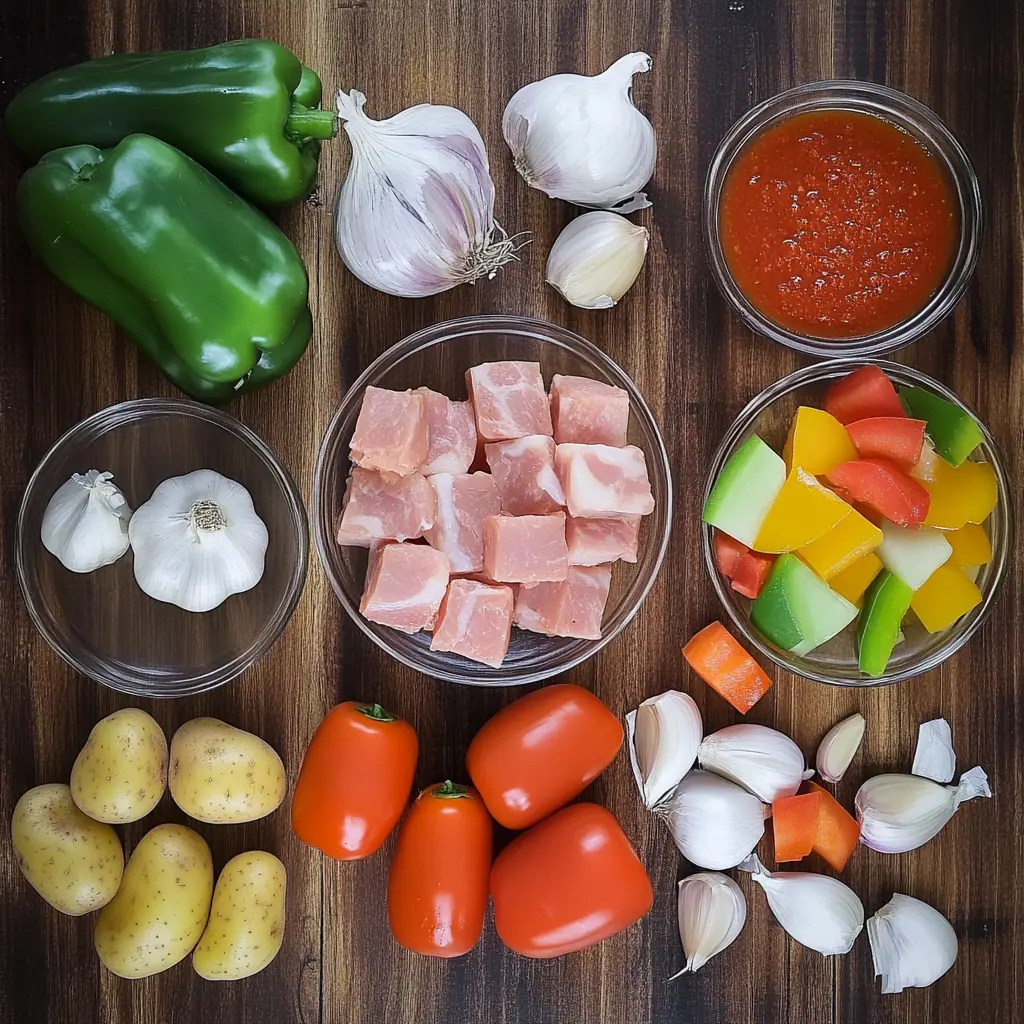
- 3 pounds pork belly or pork butt, cut into 2-inch cubes
- 1 cup tomato sauce
- 1 tablespoon tomato paste
- 1½ cups water
- 1 tablespoon fish sauce (patis)
- Salt and pepper to taste
- ¼ cup cooking oil
- 2 medium potatoes, peeled and cubed
- 2 large carrots, peeled and cubed
- 1 medium onion, finely chopped
- 4 cloves garlic, minced
- 1 green bell pepper, cubed
- 1 red bell pepper, cubed
Equipment
- Large, deep pan or Dutch oven - Provides even heat distribution and enough space for all ingredients to simmer properly
- Sharp chef's knife - Essential for cutting meat and vegetables into uniform pieces
- Cutting board - Provides a stable surface for prepping ingredients
- Measuring cups and spoons - Ensures accurate ingredient proportions
- Wooden spoon - Perfect for stirring without scratching your cookware
- Slotted spoon - Helps remove fried vegetables without taking excess oil
- Airtight containers - For storing leftovers properly
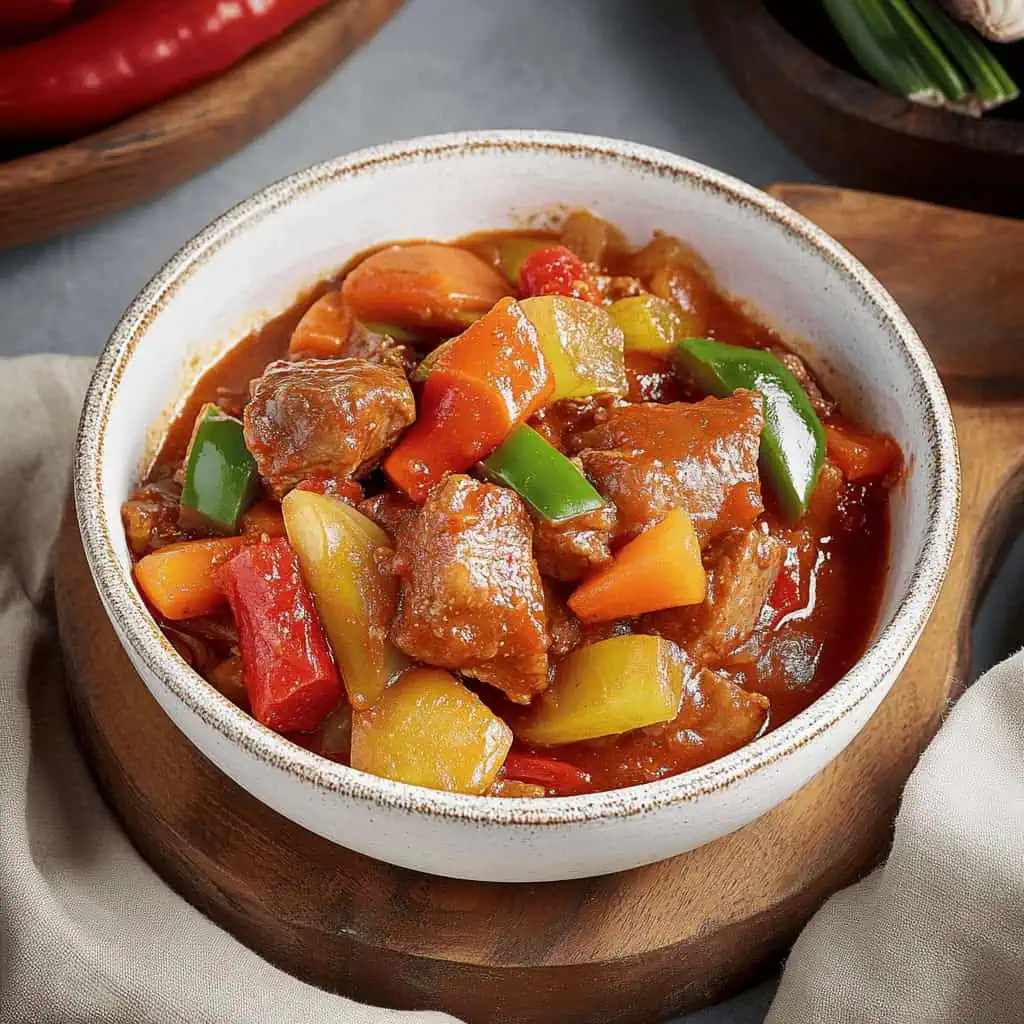
How To Make
- Begin by preparing your ingredients. Cut the pork belly into 2-inch cubes. Set aside.
- Prepare all vegetables. Peel and cut potatoes and carrots into 1-inch cubes. Finely chop the onions. Mince the garlic. Remove the seeds from bell peppers and cut into 1-inch squares.
- Place a large, deep pan over medium-high heat (190°C/375°F). Pour in the cooking oil and allow it to heat up until shimmering but not smoking.
- Once the oil is hot, fry the potato cubes until lightly golden brown, about 5-7 minutes. Remove with a slotted spoon and set aside. Do the same with the carrot cubes. Lastly, quickly sauté the bell peppers for just 30 seconds to retain their crispness. Remove and set aside with other vegetables.
- In the same pan, lower the heat to medium (175°C/350°F). Sauté the minced garlic until fragrant but not brown, about 1 minute. Add the chopped onions and continue sautéing until translucent, about 2-3 minutes.
- Increase heat back to medium-high. Add the pork cubes and cook until browned on all sides, about 7-10 minutes. Add the fish sauce and cook for another 2 minutes, stirring occasionally.
- Pour in the tomato sauce and tomato paste. Stir well to combine. Add the water and bring to a boil. Once boiling, lower the heat to a gentle simmer (150°C/300°F) and cover the pan. Let it cook for 45 minutes, stirring occasionally to prevent the bottom from sticking.
- Check the pork's tenderness by piercing with a fork. The meat should be very tender but still hold its shape. If needed, continue cooking for another 10-15 minutes.
- When the meat is tender, add back the fried potatoes and carrots. Simmer for 10-12 minutes or until the vegetables are cooked through but still firm.
- Add the bell peppers last and cook for just 2 minutes to keep their bright color and slight crunch.
- Taste and season with salt and pepper as needed.
- Let the dish rest for 5-10 minutes before serving. This allows the flavors to meld and the sauce to thicken slightly.
- Serve hot over steamed white rice.

Tips from Lola's Kitchen
- For extra flavor, marinate the pork in calamansi juice for 30 minutes before cooking
- Choose pork with some fat marbling for the best flavor and texture
- Pan-fry vegetables separately to maintain their individual textures in the final dish
- Allow the stew to rest for 15 minutes before serving to let flavors fully develop
- Add a pinch of sugar if your tomatoes are particularly acidic
- Cut all ingredients into similarly sized pieces for even cooking
- Don't rush the simmering process – slow cooking develops the rich flavors
- If you like a thicker sauce, leave the pot uncovered during the last 15 minutes of cooking
Substitutions
- Pork: Chicken thighs (cook for 30 minutes), beef chuck (simmer for 1.5-2 hours), or firm white fish (add in the last 10 minutes)
- Potatoes: Sweet potatoes or taro root work beautifully and add unique flavor
- Tomato Sauce: Blend 4 fresh tomatoes with 1 tablespoon tomato paste
- Bell Peppers: Any color works, or substitute with green peas or mixed frozen vegetables
- Fish Sauce: Soy sauce can work in a pinch (use 2 teaspoons and adjust to taste)
- Fresh Herbs: Add a bay leaf during simmering for extra depth (remove before serving)
Troubleshooting
Tough Meat?
- Ensure you've cut pieces uniformly so they cook at the same rate
- Simply simmer longer on low heat – patience is key
- Consider the quality and cut of meat – shoulder or butt cuts need more time
Watery Sauce?
- Simmer uncovered for 10-15 minutes to reduce excess liquid
- Add an additional tablespoon of tomato paste
- Next time, use less water initially – you can always add more
Vegetables Too Soft?
- Remember to pan-fry them separately before adding to the stew
- Add them later in the cooking process
- Don't overcook after adding them back to the pot
Too Acidic?
- Add ½ teaspoon of sugar to balance the acidity
- A small piece of carrot added during simmering can absorb excess acidity
- Some Filipino cooks add a splash of evaporated milk to mellow the flavor
Storage & Reheating
- Refrigerator: Store in an airtight container for 3-4 days
- Freezer: Freezes well for up to 3 months (vegetables may soften slightly)
- Reheating: Warm slowly on the stovetop over medium-low heat, adding a splash of water if needed
- Make Ahead: This dish actually tastes better the next day as the flavors continue to develop
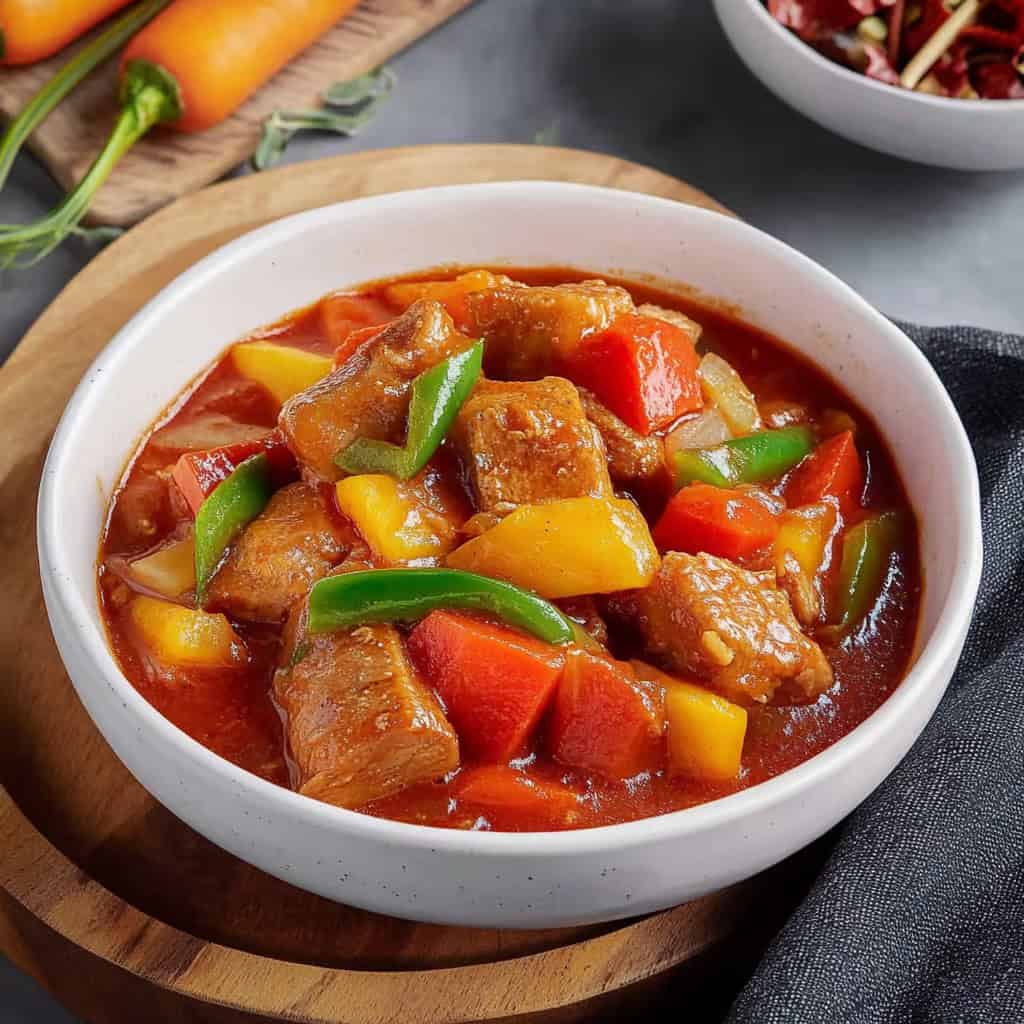
FAQ
What's the difference between Afritada, Menudo, and Mechado?
Afritada uses larger meat cuts with bell peppers in a clear tomato sauce. Menudo features smaller meat pieces with liver and raisins. Mechado includes a signature fat strip in the meat and has a deeper colored sauce.
Can I use lean pork for this recipe?
Yes, but cooking time may need adjustment, and the dish will be slightly less rich. Add a tablespoon of olive oil to compensate for the reduced fat.
Why do you pan-fry vegetables separately?
This technique helps each vegetable maintain its ideal texture and prevents them from becoming too soft during the long simmer time.
Is this recipe freezer-friendly?
Yes! Freeze in portion-sized containers for up to 3 months. The potatoes may change texture slightly, but the flavor remains excellent.
Can I make Pork Afritada in a slow cooker or pressure cooker?
Absolutely! For slow cookers, cook on low for 6-8 hours, adding vegetables in the last hour. For pressure cookers, cook pork for 25 minutes on high pressure, then add vegetables and simmer until tender.
How can I make this dish healthier?
Use pork loin instead of belly, reduce oil to 2 tablespoons, and increase the proportion of vegetables to meat.
What's the best side dish with Afritada?
Traditional steamed white rice is perfect, but garlic rice (sinangag) or crusty bread for sauce-sopping are delicious alternatives.
Can I add other vegetables to this recipe?
Yes! Green peas, string beans, or sliced cabbage are wonderful additions. Add them in the last few minutes of cooking.
Related
Looking for other recipes like this? Try these:

Filipino Pork Afritada (Afritadang Baboy)
Ingredients
For the Meat and Sauce
- 3 pounds pork belly or pork butt cut into 2-inch cubes
- 1 cup tomato sauce
- 1 tablespoon tomato paste
- 1½ cups water
- 1 tablespoon fish sauce patis
- Salt and pepper to taste
For the Aromatics and Vegetables
- ¼ cup cooking oil
- 2 medium potatoes patatas, peeled and cubed
- 2 large carrots karot, peeled and cubed
- 1 medium onion sibuyas, finely chopped
- 4 cloves garlic bawang, minced
- 1 green bell pepper berdeng siling pangsigang, cubed
- 1 red bell pepper pulang siling pangsigang, cubed
Instructions
- Begin by preparing your ingredients (Magsimula sa paghahanda ng mga sangkap). Cut the pork belly into 2-inch cubes. Set aside.
- Prepare all vegetables (Ihanda ang mga gulay). Peel and cut potatoes and carrots into 1-inch cubes. Finely chop the onions. Mince the garlic. Remove the seeds from bell peppers and cut into 1-inch squares.
- Place a large, deep pan or kawali over medium-high heat (190°C/375°F). Pour in the cooking oil and allow it to heat up until shimmering but not smoking (Initin ang mantika hanggang mainit ngunit hindi umuusok).
- Once the oil is hot, fry the potato cubes until lightly golden brown, about 5-7 minutes. Remove with a slotted spoon and set aside. Do the same with the carrot cubes. Lastly, quickly sauté the bell peppers for just 30 seconds to retain their crispness. Remove and set aside with other vegetables.
- In the same pan, lower the heat to medium (175°C/350°F). Sauté the minced garlic until fragrant but not brown, about 1 minute (Igisa ang bawang hanggang bumango). Add the chopped onions and continue sautéing until translucent, about 2-3 minutes (Idagdag ang sibuyas at igisa).
- Increase heat back to medium-high. Add the pork cubes and cook until browned on all sides, about 7-10 minutes. Add the fish sauce (patis) and cook for another 2 minutes, stirring occasionally.
- Pour in the tomato sauce and tomato paste. Stir well to combine. Add the water and bring to a boil. Once boiling, lower the heat to a gentle simmer (150°C/300°F) and cover the pan (Takpan ang kawali). Let it cook for 45 minutes, stirring occasionally to prevent the bottom from sticking (Haluin paminsan-minsan upang hindi dumikit sa ilalim).
- Check the pork's tenderness by piercing with a fork. The meat should be very tender but still hold its shape. If needed, continue cooking for another 10-15 minutes.
- When the meat is tender, add back the fried potatoes and carrots. Simmer for 10-12 minutes or until the vegetables are cooked through but still firm (Pakuluan hanggang maluto ang mga gulay ngunit hindi malambot).
- Add the bell peppers last and cook for just 2 minutes to keep their bright color and slight crunch (Ilagay ang sili at lutuin ng dalawang minuto lamang).
- Taste and season with salt and pepper as needed (Timplahan ng asin at paminta kung kinakailangan).
- Let the dish rest for 5-10 minutes before serving. This allows the flavors to meld and the sauce to thicken slightly.
- Serve hot over steamed white rice. Provide patis (fish sauce) and calamansi on the side for additional seasoning according to taste.
- For storing (Para sa pag-iimbak): Let cool completely before transferring to an airtight container. Keep in the refrigerator for up to 3-4 days. When reheating, use medium heat (175°C/350°F) and add a small amount of water if the sauce has thickened too much.
- Pork Afritada tastes even better the next day, as the flavors have more time to develop (Mas masarap ang afritada kinabukasan dahil mas nalalasahan ang mga sangkap).
- Note: If the sauce becomes too thick during cooking, add hot water ¼ cup at a time. If too thin, simmer uncovered for a few extra minutes until it reaches your desired consistency (Kung masyadong malapot ang sarsa, dagdagan ng mainit na tubig. Kung masyadong malabnaw, pakuluan hanggang sa maging tamang lapot).
Tips from Lola's Kitchen
- Marinate pork in calamansi juice for 30 minutes for extra flavor
- Use pork with some fat marbling for the best results
- Pan-fry vegetables separately to maintain their texture
- Add a dash of sugar to balance acidity if needed
- Let the stew rest for 15 minutes before serving
Nutrition
The Story Behind Filipino Pork Afritada (Afritadang Baboy)
Pork Afritada, known locally as Afritadang Baboy, traces its roots to the Spanish colonial era in the Philippines, spanning over three centuries of cultural fusion. The name itself derives from the Spanish word "fritada," meaning fried, though ironically, our beloved version has evolved into a hearty stew that's more braised than fried. This transformation perfectly exemplifies how Filipinos masterfully adapted Spanish cuisine to local tastes and ingredients.
During the Spanish colonial period, wealthy households introduced this dish using imported olive oil and Spanish paprika. However, as it made its way into Filipino kitchens across the archipelago, local cooks ingeniously substituted these hard-to-find ingredients with native alternatives. The addition of fish sauce (patis) instead of salt, and the incorporation of potatoes and carrots – vegetables introduced by the Spanish galleon trade – created the uniquely Filipino version we know today.
What sets Filipino Pork Afritada apart from its Spanish ancestor is our distinctive approach to the sauce. While the Spanish version leans towards a drier, more concentrated flavor, the Filipino adaptation embraces a saucier profile that's perfect for pairing with steamed rice. This modification reflects our culture's love for sabaw (soup or sauce) and demonstrates how we've transformed a European dish into something that feels distinctly Filipino.
In modern Filipino households, Pork Afritada holds a special place as both an everyday ulam and a celebration dish. Its versatility shines through various regional interpretations – from the slightly sweeter version preferred in Pampanga to the spicier variations found in Bicol. Despite these regional differences, the core elements remain consistent: tender pork, bright vegetables, and that signature tomato-based sauce that's become a cornerstone of Filipino comfort food.
Today, Pork Afritada stands as a testament to Filipino culinary innovation, representing our ability to adapt foreign influences while maintaining our distinct food identity. Whether served at family Sunday lunches, fiestas, or simple weekday dinners, this dish continues to evolve while remaining true to its beloved status in Filipino cuisine. Its enduring popularity among both home cooks and professional chefs proves that some recipes only get better with time, especially when filtered through the creative and resourceful Filipino cooking philosophy.
Remember: Perfect pork afritada isn't just about the sauce—it's about achieving that ideal consistency where the sauce is thick enough to coat each piece of meat and vegetable, while ensuring the pork remains tender and the potatoes hold their shape but are soft enough to help thicken the sauce.
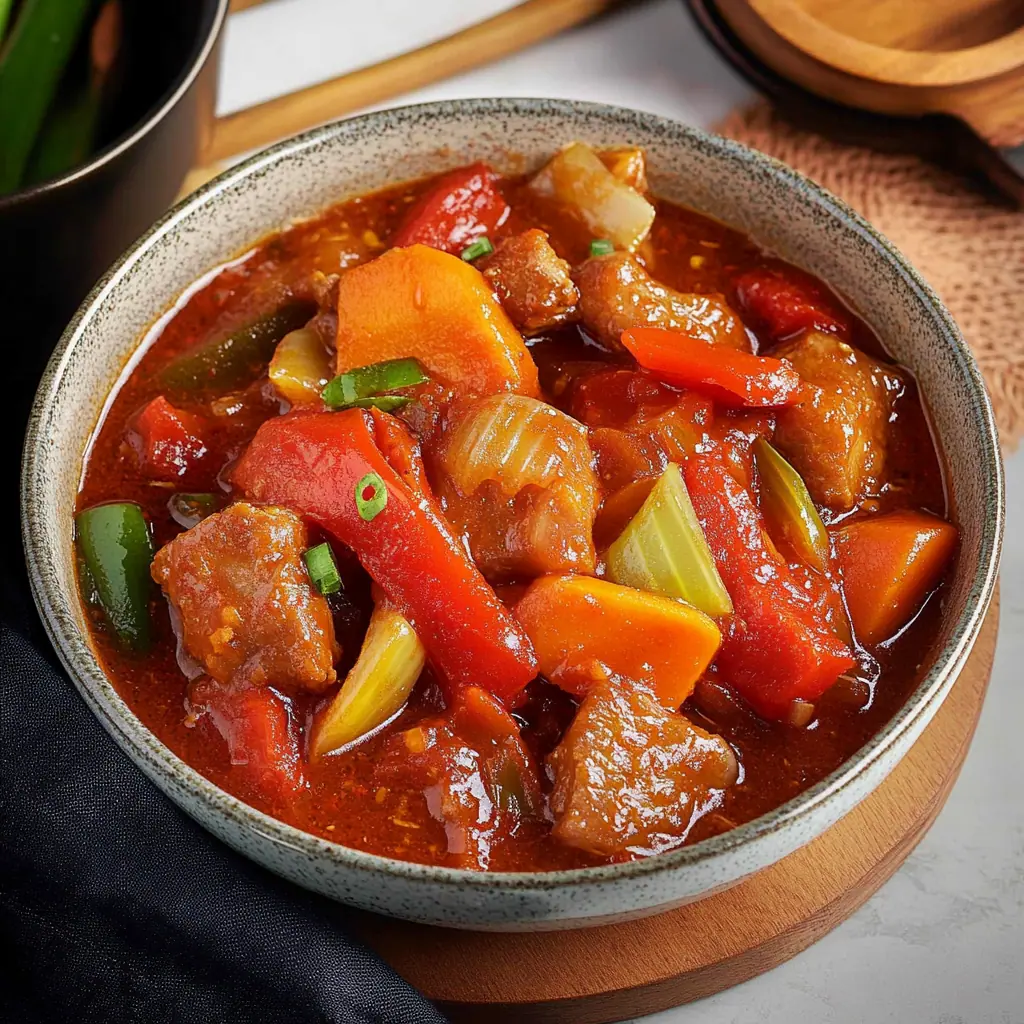









Comments
No Comments